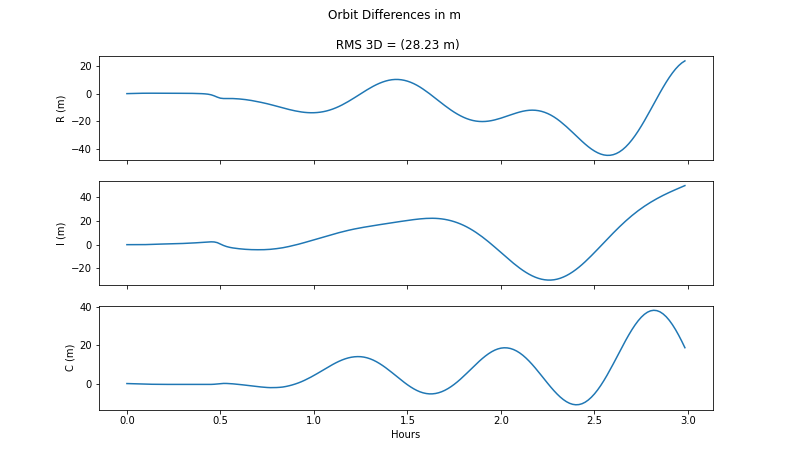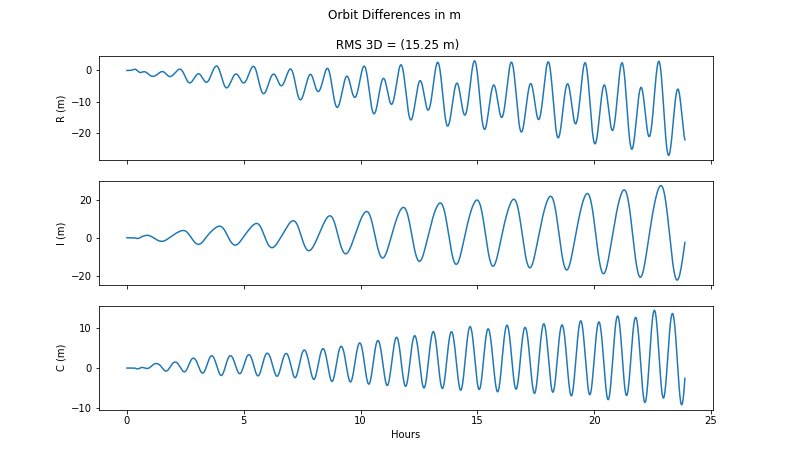Runge-Kutta 4 Orbit Propagator
World's first online orbit propagator based on Runge-Kutta 4th order method with 60 seconds fixed step size.
Propagated states in ECI frame:
Duration: h
Mass: kg
Area: m²
Notes:
-
100 km to 40000 km orbits allowed.
-
The accuracy of the propagator with 60 sec step size for a 3h run for GRACE-FO satellite can be seen in the figure. It shows RIC (Radial,In-track,Cross-track) differences between the propagated states and the GRACE-FO reference orbit.
-
Force model parameters are defined in the table below. Propagator allows smaller step sizes and better accuracy (within a few meters for a day of propagation), but it requires higher processing power. Therefore, the step size is fixed to 60 seconds and propagation duration is limited with 3h.
-
Differences from reference orbit for 24h run with 10 sec step size:

| # | Modelling parameter | Force model |
|---|---|---|
| 1 | Earth gravity field | GGM03 (21x21) |
| 2 | Atmospheric drag | NRLMSISE-00 atmospheric density model |
| 3 | Solar radiation pressure (SRP) | Cannonball model |
| 4 | Third body | Luni-solar model based on approximated sun and moon position. |
| 5 | Relativity | General relativity |
| 6 | Solid-earth tides, pole tides | Not defined |

RK4
RK4 orbit propagator is a mathematical algorithm used to predict the position and velocity of a celestial object at a future time, given its current position and velocity, and the gravitational forces acting on it. The algorithm uses a series of calculations to estimate the object's acceleration at a given point in time, and then uses that acceleration estimate to calculate a new position and velocity for the object after a small time interval. The process is repeated several times, with each new position and velocity estimate being based on the previous estimate and the acceleration at that point, until a prediction is made for the object's position and velocity at a future time. The RK4 method is known for its accuracy and efficiency and is widely used in astrodynamics and orbital mechanics. However, it's important to note that the method is an approximation and may not account for all effects that could influence an object's motion.
One of the primary advantages of the RK4 method is that it is relatively simple and computationally efficient. It is also a higher-order method, meaning that it is more accurate than many other numerical methods for orbit propagation.
However, there are also limitations to the accuracy of the RK4 method. Like all numerical methods, the accuracy depends on the step size used in the computation. The RK4 method can be sensitive to step size, and if the step size is too large, the error in the orbit propagation can accumulate quickly, leading to inaccurate results. Therefore, it is important to choose an appropriate step size based on the application and the level of accuracy required.
Additionally, the RK4 method assumes that the acceleration is constant over the time step, which may not be accurate for highly eccentric or highly elliptical orbits. In such cases, other numerical methods, such as adaptive step-size integrators or higher-order integrators, may be more appropriate to achieve higher accuracy.

Online RK4 orbit propagation web tool is very beneficial for astronomers, scientists, and experts in a number of ways.
- Accessibility: The web tool is free and open to everyone with internet access. It increases accessibility to orbit propagation tools. It can help scientists and students who do not have access to specialized software or computing resources to carry out research or assignments that require orbit propagation.
- Simplify orbit propagation: Orbit propagation is a complex process that requires specialized knowledge and software. An online RK4 orbit propagation web tool could simplify this process by providing a user-friendly interface that makes it easier for scientists and experts to input the necessary parameters and obtain accurate results.
- Save time and resources: By eliminating the need for specialized software and hardware, an online tool can save astronomers and scientists a significant amount of time and resources. It can also reduce the need for manual calculations and increase the efficiency of the orbit propagation process.
- Improve accuracy: The RK4 method is a higher-order method that is more accurate than many other numerical methods for orbit propagation. An online tool that implements RK4 can provide more accurate results, which can be especially important for applications that require high precision.
- Support research: Online RK4 orbit propagation tool can support research in many areas, including astrodynamics, celestial mechanics, and satellite tracking. It can also be used for educational purposes, providing students and researchers with a tool to explore the dynamics of the solar system and other celestial objects.
- Increase collaboration: The web tool can facilitate collaboration between researchers and scientists by providing a common platform for orbit propagation. It can also enable the sharing of data and results, which can support scientific inquiry and help to advance the field of astronomy and astrophysics.